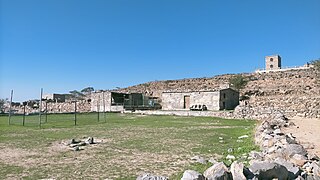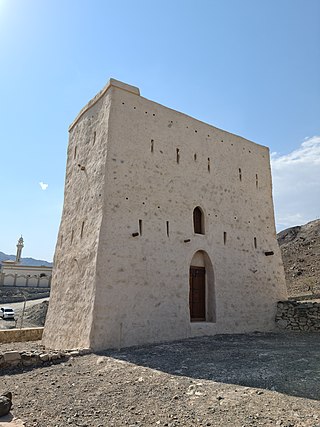Related Research Articles
The Al Ali is a tribe of the Arabian Peninsula, notably in the United Arab Emirates. The tribe originally settled the island of Siniyah off Umm Al Quwain, later moving to the mainland and building a fort and defensive wall there in the late 1700s, founding the emirate of Umm Al Quwain. The emirate consists in the main of the coastal city of Umm Al Quwain and the inland oasis town of Falaj Al Mualla, some 30 km from the coast.
The Bani Kaab is an Arab tribe in Oman and the United Arab Emirates, also evident in other Gulf countries.
The Shihuh is an Arab tribe living in the United Arab Emirates (UAE) and Oman. In the singular, the name is Al Shehhi, a common family name in the UAE and Oman today. Inhabiting the northern part of the Hajar Mountain range, specifically in the Ruus Al Jibal, the tribe has long been influential in the affairs of both the east and west coast settlements of the northern UAE and Oman and has fiercely maintained both its identity and independence.
Al Qor is a settlement in Ras Al Khaimah, United Arab Emirates (UAE). The area is rich in archaeological sites and finds date human settlement back to the Umm Al Nar period – 2600 BCE. Al Qor is located within the Wadi Qor and is prone to intense flooding. It was traditionally home to the Bani Kaab tribe.

Baqal is a small agricultural and livestock town, located in the northeast of the U.A.E., in the Hajar Mountains of the Emirate of Ras Al Khaimah.
Huwaylat is a settlement in Ras Al Khaimah, United Arab Emirates (UAE). A small village in the Wadi Qor, it is the site of three Umm Al Nar period tombs.
Munay is the name of a village in Ras Al Khaimah, one of the United Arab Emirates. It sits at the head of the Wadi Qor.
Rafaq is the name of a settlement in Ras Al Khaimah in the United Arab Emirates (UAE), in the Wadi Qor. It was visited in 2008 by Mohammed bin Rashid Al Maktoum as part of a tour of remote mountain communities by the Ruler of Dubai.

Al Hayl is a suburb of Fujairah, United Arab Emirates (UAE), at the mouth of the Wadi Hayl. The old village in the Wadi Hayl is traditionally the home of the Kunud tribe.

Al Nasla is a settlement in Ras Al Khaimah in the United Arab Emirates (UAE). It is situated in the Wadi Qor below Rafaq.
The Naqbiyin is a tribe of the United Arab Emirates (UAE). They are mostly settled within the emirates of Sharjah and Ras Al Khaimah and have long been influential in the tribal politics of both emirates.
Bithnah is a village in Fujairah, United Arab Emirates (UAE), long occupying a strategic location in the Wadi Ham, which is the only natural link to the interior of the UAE and the Persian Gulf from the East Coast city, and Emirate of Fujairah.
Sheikh Rashid bin Ahmad Al Mualla was the Ruler of Umm Al Quwain from 1904–1922, one of the Trucial States and today one of the seven emirates forming the United Arab Emirates (UAE). He gained influence over the tribes of the interior at the expense of the pre-eminent Trucial Ruler of the time, Sheikh Zayed bin Khalifa Al Nahyan.
The Bani Qitab is an Arab tribe of the United Arab Emirates (UAE) and Oman. The singular form of the name, Al Ketbi, is a common family name in the Northern UAE today. Consisting of a settled southern section and a nomadic northern section, the tribe was long influential in the conduct of affairs in the interior of the Trucial States. The Northern branch mostly settled in the inland towns of Dhaid and Al Falayah.
The Na'im is an Arab tribe in the United Arab Emirates. The tribe is also present in other gulf countries.
Wadi Qor is a seasonal watercourse in the Hajar Mountains of Ras Al Khaimah, in the United Arab Emirates. The wadi runs from the mountain village of Al Qor, near the Dubai exclave of Hatta, through the villages of Huwaylat, Rafaq and Al Nasla before crossing the Omani border and fanning out to the Batinah plain and the Gulf of Oman north of the Omani coastal village of Bu Baqarah.

Wadi Sidr is a seasonal watercourse, or wadi, in the Hajar Mountains of Fujairah, United Arab Emirates. It runs in a south-westerly direction from the village of Wadi Sidr, where it is dammed by the Wadi Sidr Dam, constructed in 2001, to the confluence of the Wadi Asimah with the Wadi Fara.
The Wadi Safad, is a valley or dry river, with ephemeral or intermittent flow, which flows almost exclusively during the rainy season, located northeast of the United Arab Emirates, in the Emirate of Fujairah.

The Wadi Hatta is a valley or dry river with ephemeral or intermittent flow, which flows almost exclusively during the rainy season, located north of Oman, in the Al Batinah North; and to the east of the United Arab Emirates, in the enclave of Hatta (Dubai).